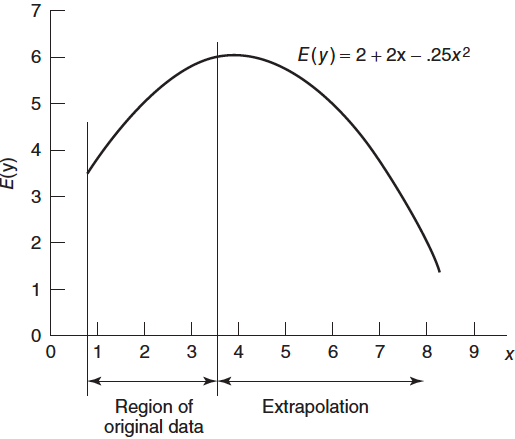
Polynomial Regression ▶️
MATH 4780 / MSSC 5780 Regression Analysis
Department of Mathematical and Statistical Sciences
Marquette University
Polynomial Regression
Polynomial Models in One Variable
Piecewise Regression
Splines
Why Polynomial Regression
- Polynomials are widely used in situations where the response surface is curvilinear.
- Many complex nonlinear relationships can be adequately modeled by polynomials over reasonably small ranges of the \(x\)’s.

Polynomial Regression Models
A second-order (degree) polynomial in one variable or a quadratic model is \[y = \beta_0 + \beta_1 x + \beta_2 x^2 + \epsilon\]
A second-order polynomial in two variables is \[y = \beta_0 + \beta_1 x_1 + \beta_2 x_2 + \beta_{11}x_1^2 + \beta_{22}x_2^2 + \beta_{12}x_1x_2 + \epsilon\]
The \(k\)th-order polynomial model in one variable is \[y = \beta_0 + \beta_1 x + \beta_2 x^2 + \cdots + \beta_kx^k + \epsilon\]
If we set \(x_j = x^j\), this is just a multiple linear regression model with \(k\) predictors \(x_1, x_2, \dots, x_k\)!
Important Considerations
Keep the order of the model as low as possible.
Transform data to keep the model 1st order.
If fails, try a 2nd order model.
Avoid higher-order polynomials unless they can be justified for reasons outside the data.
-
👉 Occam’s Razor: among competing models that predict equally well, choose the “simplest” one, i.e., a parsimonious model.
- This avoids overfitting that leads to nearly perfect fit to the data, but bad prediction performance.
“Bayesian Deep Learning and a Probabilistic Perspective of Generalization” Wilson and Izmailov (2020) for the rationale of choosing a super high-order polynomial as the regression model.
Important Considerations
Model building strategy
👉 Forward selection: successively fit models of increasing order until the \(t\)-test for the highest order term is non-significant.
👉 Backward elimination: fit the highest order model and then delete terms one at a time until the highest order remaining term has a significant \(t\) statistic.
👉 They do not necessarily lead to the same model.
👉 Restrict our attention to low-order polynomials.
Important Considerations
Extrapolation
- Can be extremely dangerous when the model is higher-order polynomial.
- The nature of the true underlying relationship may change or be completely different from the system that produced the data used to fit the model.

Important Considerations
Ill-conditioning
- Ill-conditioning: as the order of the model increases, \({\bf X'X}\) matrix inversion will become inaccurate, and error may be introduced into the parameter estimates
- Centering the predictors may remove some ill conditioning but not all.
- One solution is to use orthogonal polynomials (LRA Sec 7.5).
Example 7.1: Hardwood Data (LRA)
- Strength of kraft paper vs. the percentage of hardwood in the batch of pulp from which the paper was produced.
- A quadratic model may adequately describe the relationship between tensile strength and hardwood concentration.
R Lab Hardwood Data Model Fitting
- Following the suggestion that centering the data may remove nonessential ill-conditioning: \[y = \beta_0 + \beta_1 (x - \bar{x}) + \beta_2 (x - \bar{x}) ^ 2 + \epsilon\]
conc_cen <- hardwood$conc - mean(hardwood$conc)
lm(strength ~ conc_cen + I(conc_cen ^ 2), data = hardwood)
Call:
lm(formula = strength ~ conc_cen + I(conc_cen^2), data = hardwood)
Coefficients:
(Intercept) conc_cen I(conc_cen^2)
45.295 2.546 -0.635 - \(y = 45.3 + 2.55 (x - 7.26) - 0.63 (x - 7.26) ^ 2 + \epsilon\)
- Inference, prediction and residual diagnostics procedures are the same as multiple linear regression.
Piecewise (Polynomial) Regression
- A polynomial regression may provide a poor fit, and increasing the order does not improve the situation.
- This may happen when the regression function behaves differently in different parts of the range of \(x\).
SOLUTION: 👉 piecewise polynomial regression that fits separate polynomials over different regions of \(x\).
Example: \[y=\begin{cases} \beta_{01} + \beta_{11}x+ \beta_{21}x^2+\beta_{31}x^3 +\epsilon & \quad \text{if } x < c\\ \beta_{02} + \beta_{12}x+ \beta_{22}x^2+\beta_{32}x^3+\epsilon & \quad \text{if } x \ge c \end{cases}\]
The joint points of pieces are called knots.
- Using more knots leads to a more flexible piecewise polynomial.
With \(K\) different knots, how many different polynomials do we have?
U.S. Birth Rate from 1917 to 2003
R Lab A Polynomial Regression Provide a Poor Fit


R Lab Piecewise Polynomials: 3 knots at 1936, 60, 78

Any issue of piecewise polynomials?
Splines
Splines of degree \(k\) are piecewise polynomials of degree \(k\) with continuity in derivatives (smoothing) up to degree \(k-1\) at each knot.
- Use
bs()function in the splines package.

Cubic Splines
- The cubic spline is a spline of degree 3 with first 2 derivatives are continuous at the knots.

Practical Issue
-
How many knots should be used
- As few knots as possible
- At least 5 data points per segment
-
Where to place the knots
- No more than one extreme point per segment
- If possible, the extreme points should be centered in the segment
-
What is the degree of functions in each region
- Cubic spline is popular

